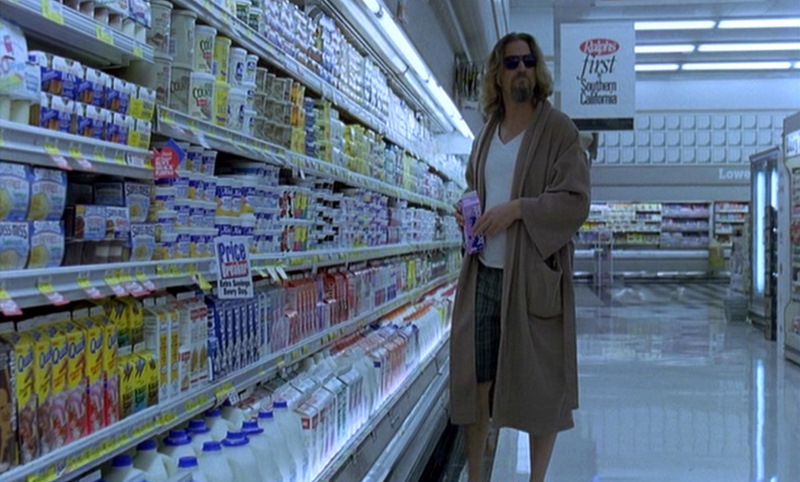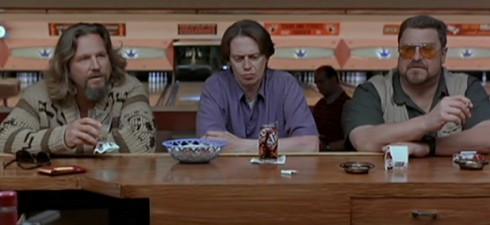‘Sometimes there’s a man. . . and he’s the man for his time and place.’
The Big Lebowski (1998) is a film about a man who ‘nobody calls. . . Lebowski.’ He is ‘The Dude’ (Jeff Bridges): and his journey to secure a replacement rug for his home pits him against his friends, a millionaire, a pornographer and a band of marmot-wielding nihilists. I’m not going to describe the plot. If you haven’t seen this film, then you’d better get hold of the DVD and watch it so you’ll be able to die with a smile on your face without feeling like the good lord gipped you.

As the protagonist’s self-applied name suggests, The Big Lebowski is a film about a man. That’s not to say it’s not about women, too. But it’s true: The Dude is a guy. And in early ’90’s LA, masculinity is in crisis. George H. W. Bush is bombing the heck out of Iraq, Vietnam vets are struggling with middle age and obesity, and it truly seems that ‘the bums lost’ in the now-distant idealism of the 1960’s and 70’s. Nihilists have promised to ‘cut off [The Dude’s] Johnson’: a threat that worries him significantly. The ways in which competing models of masculinity are portrayed in the film are various: the disabled Mr Lebowski asks ‘what makes a man?’, to which The Dude answers ‘a pair of testicles’. Yet, as well as his testicles and his now-endangered Johnson, The Dude’s identity is constructed with a number of objects and places that he surrounds himself with.
First: of course — is the bowling alley. The film’s thrilling opening sequence does more than any other cinematic moment to make bowling look damned cool. It’s a space for male bonding: a team-sport consisting of the launching of projectiles down a runway to knock over a helpless configuration of skittles. Perhaps no more fitting domestic metaphor for the war in Iraq could be imagined. Yet, as The Dude’s friend Walter insists (with a loaded gun): ‘This is not ‘Nam! This is bowling! There are rules!’ The bowling alley becomes the space for discussion of religion, sexual perversion and The Dude’s deepening crisis. The bowling alley is a place to escape the rest of the world and share a ‘Lite’ beer with guy friends, but probably not a place to bring your ex-wife’s Pomeranian.
Moving on. In suburban, west-coat America, no commodity represents individuality (and especially male individuality) more than the automobile, and The Dude’s car gets progressively more trashed as the film goes on. First, his friend Walter suggests a crazy scheme to trick the apparent-kidnappers out of their million dollars, which goes badly wrong, and results in The Dude running the car off the road. Then, after a game of bowling, the Dude finds the (totally worthless) car has been stolen. As he tells the police about the theft, he lists valuable items within the car: including a tape deck and Creedence Clearwater Revival tapes. The police tell him ‘I wouldn’t hold out much hope for the tape deck. / Or the Creedence.’ CCR is a kickback to the countercultural west, and the songs capture that period with a hard, salty edge. I can’t provide you with a tape, but let’s have a listen:
 Finally, (to use the parlance of our times) let’s get to the drinks. The first view we get of The Dude is at the supermarket, as he shops for a carton of milk: one of the three ingredients for his drink of choice: the ‘White Russian’ or ‘Caucasian’. For much of the film, The Dude is either sipping or carrying one of these white, creamy beverages: amazingly, even avoiding to spill it as he is dragged into a limo. Following the cult success of The Big Lebowski, the ‘White Russian’ enjoyed a huge surge in popularity. The drink perfectly represented and conveyed The Dude’s mode of being. Simple, but with a perfect combination of bite (2 parts Vodka) and smoothness (1 part Kahlua coffee liqueur, 1 part cream), it demonstrates The Dude’s insistence on taking it easy: easy preparation, easy taste. In his home, he grabs one of two huge bottles of Kahlua and mixes the drink himself, then holding it level in one hand as he carries out a martial-art-style move on his new rug. Balance has been achieved: expressed through a cold beverage in an old-fashioned glass.
Finally, (to use the parlance of our times) let’s get to the drinks. The first view we get of The Dude is at the supermarket, as he shops for a carton of milk: one of the three ingredients for his drink of choice: the ‘White Russian’ or ‘Caucasian’. For much of the film, The Dude is either sipping or carrying one of these white, creamy beverages: amazingly, even avoiding to spill it as he is dragged into a limo. Following the cult success of The Big Lebowski, the ‘White Russian’ enjoyed a huge surge in popularity. The drink perfectly represented and conveyed The Dude’s mode of being. Simple, but with a perfect combination of bite (2 parts Vodka) and smoothness (1 part Kahlua coffee liqueur, 1 part cream), it demonstrates The Dude’s insistence on taking it easy: easy preparation, easy taste. In his home, he grabs one of two huge bottles of Kahlua and mixes the drink himself, then holding it level in one hand as he carries out a martial-art-style move on his new rug. Balance has been achieved: expressed through a cold beverage in an old-fashioned glass.
We’ve taken the most brief tour of the Coen brothers’ masterpiece in a series of places and senses: the bowling alley, the trashed automobile with the Creedence tape, and the White Russian cocktail. Yet these objects are really just the accessories that are expressions, surrounding The Dude himself. The Dude is the distillation of his time and place: LA in the early 90s, as the film tells us. He is the right man for that time and place. And that’s why we love watching his adventure. Anything more than that must just be ‘well, uh, just like, uh, your opinion, man.’
And with that, I leave you with a vision. The Dude Abides.
;
NEXT WEEK: Tying in with Mel’s post on ‘Sacred Cows’ this week, let’s take a look at a head-on, direct and sceptical view of religion, with Kevin Smith and ‘Dogma’ (1999). For our schedule, check in here.

Definitely the Coen Brothers (and Jeff Bridges) at their best. Nice review.
The script is incredible. SO quotable.
And there are so many brilliant performances… John Goodman: I don’t know if I’ve seen him do a better job anywhere. Julianne Moore is always amazing… and John Turturro (Jesus): so good. Philip Seymour Hoffman is hilarious as the Big L’s butler, and the list could go on. It’s got Flea from the Red Hot Chili Peppers as a nihilist, ftw!
Can’t believe it took so long to be a commercial success: I was too young to know (or see it, being a Cert. 18 in the UK when I was 15!)
I saw it in the theater while I was at BYU. My husband, our friend and I were the only ones in the audience (another couple walked out, but that happened all the time) and it was just an instant classic. I don’t think a day goes by when Jared and I don’t quote The Big Lebowski, without it, our inside jokes would seriously suffer.
Oh, one of my favorites! We are having a Big Lebowski party in a couple of weeks with some friends who have never seen the film. The White Russians will flow like wine, y’all should come over :) “There’s a beverage here man!”
Sounds awesome, K: wish I could be there!
I’ve got a friend who hasn’t seen it either, tho: I should organise a Big L party over this way.
Absolutely! The Big Lebowski is the makings for the most excellent party ever! You can even have relay races to see who spills their drink last or something. I wish you could just just teleport over :)
“. . .And even if he’s a lazy man — and the Dude was most certainly that, quite possibly the laziest in Los Angeles County, which would place him high in the runnin’ for laziest worldwide. . .”
http://6dollarshirts.com/t-shirts/Little-Lebowski-Urban-Achiever-p-11237.html
T-shirts are like the Dead Sea Scrolls of our time. Full of obscure references from dubious sources.
This is a great write up Andy, thanks. It really is amazing how quotable the film is.
Given the connection of D&S to Mormonism, we should note that Jesus plays an essential role in the bowling alley:
http://www.youtube.com/watch?v=FbmqEiqMq4Y&feature=related
(There are so many great mash-up Labowski videos on you tube).
lol, so many brilliant quotes in that video, Ian. Would you offer a reading of ‘Jesus’ in connection to Mormonism, then? :) I don’t think I dare!
I leave a leave a response whenever I like a post on a website or I have something to contribute to the conversation. Usually it is caused by the passion displayed in the article I read. And after this post The Big Lebowski. I was actually moved enough to post a leave a responsea response :-P I do have a couple of questions for you if it’s okay. Is it just me or do a few of these responses look like they are written by brain dead folks? :-P And, if you are writing on additional online sites, I’d like to keep up with anything new you have to post. Could you make a list every one of all your shared sites like your Facebook page, twitter feed, or linkedin profile?